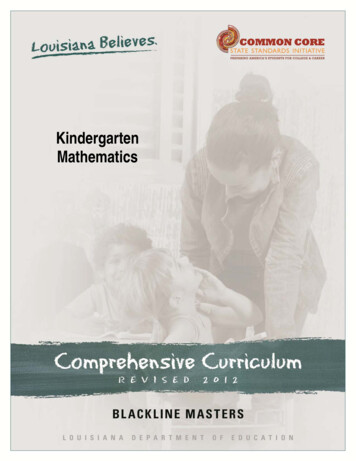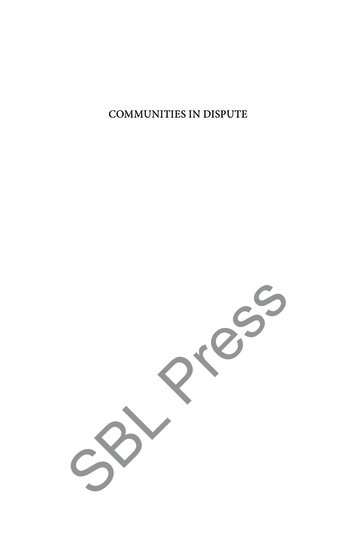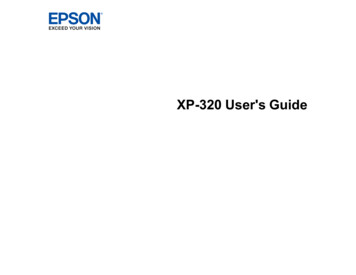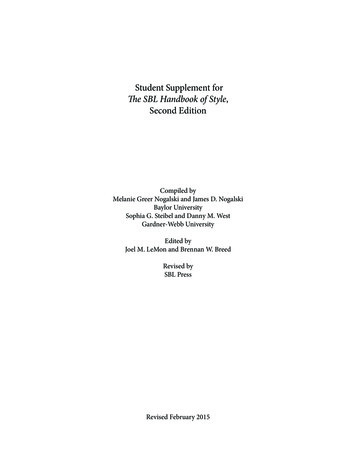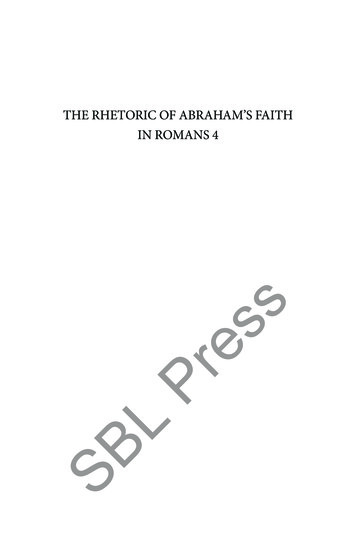
Transcription
SBLPressTHE RHETORIC OF ABRAHAM’S FAITHIN ROMANS 4
EMORY STUDIES IN EARLY CHRISTIANITYSBLPresNumber 20sVernon K. Robbins, General EditorDavid B. Gowler, General EditorBart B. Bruehler, Associate EditorRobert H. von Thaden Jr., Associate EditorRichard S. AscoughJuan Hernández Jr.Susan E. HylenBrigitte KahlMikeal C. ParsonsChristopher C. RowlandRussell B. SissonShively T. J. SmithElaine M. Wainwright
THE RHETORIC OF ABRAHAM’S FAITHIN ROMANS 4SBLPressAndrew Kimseng Tan
AtlantaCopyright 2018 by Andrew Kimseng TanPublication of this volume was made possible by the generous support of the Pierce Program in Religion of Oxford College of Emory University.The editors of this series express their sincere gratitude to David E. Orton and Deo Publishing for publication of this series 2009–2013.All rights reserved. No part of this work may be reproduced or transmitted in any formor by any means, electronic or mechanical, including photocopying and recording, or bymeans of any information storage or retrieval system, except as may be expressly permitted by the 1976 Copyright Act or in writing from the publisher. Requests for permissionshould be addressed in writing to the Rights and Permissions Office, SBL Press, 825 Houston Mill Road, Atlanta, GA 30329 USA.Library of Congress Cataloging-in-Publication DataPressNames: Tan, Andrew Kim Seng, author.Title: The rhetoric of Abraham’s faith in Romans 4 / by Andrew Kim Seng Tan.Description: Atlanta : SBL Press, 2018. Series: Emory studies in early Christianity ;Number 20 Includes bibliographical references and index.Identifiers: LCCN 2017060320 (print) LCCN 2018012706 (ebook) ISBN 9780884142904(ebk.) ISBN 9781628372083 (pbk. : alk. paper) ISBN 9780884142898 (hbk. : alk.paper)Subjects: LCSH: Bible. Romans, IV—Socio-rhetorical criticism. Abraham (Biblicalpatriarch)Classification: LCC BS2665.52 (ebook) LCC BS2665.52 .T36 2018 (print) DDC227/.1066—dc23LC record available at https://lccn.loc.gov/2017060320SBLCover design is an adaptation by Bernard Madden of Rick A. Robbins, Mixed Media (19"x 24" pen and ink on paper, 1981). Cover design used by permission of Deo Publishing.Printed on acid-free paper.
ction.1Statement of the Problem1Literature Review3Thesis Statement13s1. Approach of Interpretation.15Introduction15Textures of a Text16Rhetorolects2229ConclusionPres2. Rhetorical Contextual Framework of Romans 4.31Introduction31The Implied Rhetorical Situation of Romans31The Argument of Romans 1:16–4:2558Outworking of Abraham’s Trust in Romans 472SBL3. The Rhetoric of Romans 4: Part 1.111Introductory Matters111124Romans 4:1: A Question of FatherhoodRomans 4:2–8: Abraham Did Not Earn Righteousness,and Hence Fatherhood, by the Mosaic Law1404. The Rhetoric of Romans 4: Part 2.201Romans 4:9–12: Constructing a Myth of Origins for201Judean and Gentile Christians
viCONTENTSRomans 4:13–16: Reliance on the Mosaic Law Abolishesthe PromiseRomans 4:17–25: Trust Realizes Abraham’sWorldwide Fatherhood2182445. Summary and Conclusion.271Summary271Conclusion2736. Bibliography.275SBLPressAncient Sources Index.307Modern Authors Index.321Subject Index.327
AcknowledgementsLPressI am very grateful to Associate Professor Charles A. Wanamaker, my Doktorvater, for his valuable comments on various portions of this book. Hismany years of Christian friendship and New Testament scholarship havebeen my encouragement.I am indebted to Professor Vernon K. Robbins not only for acceptingthis manuscript into the Emory Studies in Early Christianity series butalso for pioneering sociorhetorical interpretation. His interpretive analytic has helped me better understand the rhetoric of Rom 4 by fosteringa dialogic relationship with scholars from various disciplines. His numerous suggestions and constant encouragement steered this work towardpublication.I wish to thank the Pierce Program in Religion at Oxford College ofEmory University for supporting the production of this book. I want tothank the editorial team at SBL Press.The members and leaders of Tree of Life Christian Church, Teo ChinTian, Liu Kerh Li, Koo Sin Kok, and Lawrence Lai, have been my constantencouragement in the course of my research and writing. They have beenvery patient with their proverbial busy pastor. Edmund Phang has been agood companion for many years in the pursuit of God’s Word.Leong Koon Yoke, to whom I dedicate this book, is a wife of noblecharacter (Prov 31:10–31). She is always encouraging me to do the willof the Lord. My parents, Tan Bah Chek and Seet Lee Wah, and my sons,Shuen Yi and Yan Yi, prayed regularly for me. Their prayers have been mystrength. To these people, I owe an unpayable debt.SBΜόνῳ σοφῷ θεῷ, διὰ Ἰησοῦ Χριστοῦ, ᾧ ἡ δόξα εἰς τοὺς αἰῶνας, ἀμήν— Rom 16:27-vii-
LSBsesPr
AbbreviationsPrimary SourcesLPress1 Maccabees2 Baruch (Syriac Apocalypse)1 Maccabees4 MaccabeesFlorilegiumPesher GenesisApocalypse of AbrahamPhilo, De AbrahamoAdditions to EstherJosephus, Against ApionPlutarch, AlexanderCicero, De amicitiaTacitus, AnnalesJosephus, Jewish AntiquitiesAristotle, Athēnaiōn politeiaBaruchSeneca, De beneficiisDiodorus, Bibliotheca historicaSuetonius, Gaius CaligulaHesiod, Catalogue of WomenCairo Genizah copy of the Damascus DocumentSuetonius, Divus ClaudiusSeneca, De clementiaDemetrius, De elocutioneLibanius, Epistulae; Martial, Epigrammata; Pliny theYounger, Epistulae; Seneca, Epistulae moralesSeneca the Elder, Excerpta controversiaeCicero, Epistulae ad familiaresSB1 Macc2 Bar.2 Macc4 Macc4QFlor4QpGenApoc. Ab.Abr.Add EsthAg. Ap.Alex.Amic.Ann.Ant.Ath. pol.BarBen.Bib. hist.Cal.Cat.CDClaud.Clem.Eloc.Ep.Ex. con.Fam.-ix-
xsesPrSBPol.Prog.Pss. Sol.Rhet.Rhet. Her.Rhod.Sat.Sib. Or.SirT. Jud.T. Reu.Tib.TobTop.Plutarch, De fraterno amoreAristotle, De generatione animaliumStrabo, GeographicaHerodotus, Historiae; Tacitus, HistoriaeDio Cassius, Historia romanaJustinian, InstitutionesQuintilian, Institutio oratoriaCicero, De inventione rhetoricaJoseph and AsenathJubileesSuetonius, Divus JuliusHippocrates, Jus jurandum (Ὅρκος)Philo, Legatio ad GaiumLetter of AristeasSeptuagintPlautus, MenaechmiPlato, MenexenusPhilo, De vita MosisMasoretic TextPliny the Elder, Naturalis historiaCicero, De natura deorumCicero, De officiisWestermann, W. L., et al., eds. Columbia Papyri. 11vols. New York: Columbia University Press, 1929–1954; Missoula: Scholars Press, 1979–1998Aristotle, PoliticaAelius Theon, ProgymnasmataPsalms of SolomonAristotle, RhetoricaRhetorica ad HerenniumDio Chrysostom, Rhodiaca (Or. 31)Juvenal, SatiraeSibylline OraclesSirachTestament of JudahTestament of ReubenSuetonius, TiberiusTobitCicero, TopicaLFrat. amor.Gen. an.Geogr.Hist.Hist. rom.Inst.Inst. orat.Inv.Jos. Asen.Jub.Jul.Jusj.Legat.Let. Aris.LXXMen.Menex.Mos.MTNat.Nat. d.Off.P.Col.ABBREVIATIONS
xiABBREVIATIONSVirt.WarWisPhilo, De virtutibusJosephus, Jewish WarWisdom of SolomonSecondary bANRWAnchor BibleFreedman, David Noel, ed. Anchor Bible Dictionary.6 vols. New York: Doubleday, 1992Archaeology and Biblical StudiesAnalecta BiblicaTemporini, Hildegard, and Wolfgang Haase,eds. Aufstieg und Niedergang der römischen Welt:Geschichte und Kultur Roms im Spiegel der neuerenForschung. Part 2, Principat. Berlin: de Gruyter,1972–Charles, R. H. The Apocrypha and Pseudepigraphaof the Old Testament. Oxford: Clarendon, 1913Aarhus Studies in Mediterranean AntiquityAmerican Schools of Oriental Research Dissertation SeriesAndrews University Seminary StudiesBiblical ArchaeologistWalter, Bauer, Frederick W. Danker, William F.Arndt, and F. Wilbur Gingrich. Greek-English Lexicon of the New Testament and Other Early ChristianLiterature. 3rd ed. Chicago: University of ChicagoPress, 2000Brown, Francis, S. R. Driver, and Charles A. Briggs.A Hebrew Lexicon of the Old Testament. Oxford:Clarendon Press, 1907Blass, Friedrich, and Albert Debrunner, and RobertW. Funk. A Greek Grammar of the New Testamentand Other Early Christian Literature. Chicago: University of Chicago Press, 1961Baker Exegetical Commentary on the New TestamentBerytus: Archaeological StudiesBeiträge zur evangelischen TheologiePrABABDBECNTBerytusBEvT
eiträge zur historischen TheologieBiblicaBiblical Interpretation SeriesThe Bible and Its Modern InterpretersBlack’s New Testament CommentariesBiblical Theology BulletinBeihefte zur Zeitschrift für die alttestamentlicheWissenschaftCambridge Bible CommentaryCatholic Biblical QuarterlyCurrents in Biblical ResearchClassics and Contemporary ThoughtChicago-Kent Law ReviewConiectanea Biblica: New Testament SeriesCovenant QuarterlyClassical ReviewCompendia Rerum Iudaicarum ad Novum TestamentumEarly Christianity and Its LiteratureEdinburgh Readings on the Ancient WorldEthnic and Racial StudiesEuropean Review of Social PsychologyEnglish Standard VersionEvangelical QuarterlyEvangelische TheologieThe Expository TimesFrankfurter Althistorische BeiträgeForschung zur BibelHerders Theologischer Kommentar zum NeuenTestamentHarvard Theological ReviewHervormde Teologiese StudiesInterpretation: A Bible Commentary for Teachingand PreachingInternational Critical CommentaryInscriptiones Graecae. Editio Minor. Berlin: deGruyter, 1924–International Journal of Philosophical BREVIATIONSIJPSInt
SMAARMTMTZNCBCNEBNICNTPrJSOTJSOTSupJournal of Biblical LiteratureJournal of the Evangelical Theological SocietyJournal for the Study of JudaismJournal for the Study of the New TestamentJournal for the Study of the New Testament Supplement SeriesJournal for the Study of the Old TestamentJournal for the Study of the Old Testament Supplement SeriesJournal of Theological StudiesKing James VersionLoeb Classical LibraryLibrary of Early ChristianityLeicester-Nottingham Studies in Ancient SocietyThe Library of New Testament StudiesMemoirs of the American Academy in RomeMasoretic TextMünchener theologische ZeitschriftNew Century Bible CommentaryNew English BibleNew International Commentary on the New TestamentNew International Commentary on the Old TestamentNew International VersionNovum TestamentumNovT SupplementsNew Revised Standard VersionNew Testament StudiesNumen Book SeriesOrbis Biblicus et OrientalisOxford Classical MonographsCharlesworth, James H., ed. Old Testament Pseudepigrapha. 2 vols. New York: Doubleday, 1983–1985Paideia: Commentaries on the New TestamentPhilosophy and RhetoricQuarterly Journal of SpeechReview of Biblical LiteratureResources for Biblical StudyLJBLJETSJSJJSNTJSNTSup
RASBLSBLDSSBLSBSMichel, Charles. Recueil des Inscriptions Grecques.Brussels: Lamertin, 1900. Repr. Hildesheim: Olms,1976.Rhetoric of Religious AntiquitySociety of Biblical LiteratureSociety of Biblical Literature Dissertation SeriesSociety of Biblical Literature Sources for BiblicalStudySociety of Biblical Literature Texts and TranslationsStudies in Christian-Jewish RelationsSupplementum epigraphicum graecum. Amsterdam:Gieben, 1923–Dittenberger, Wilhelm. Sylloge inscriptionum graecarum. 3rd ed. 4 vols. Leipzig: Hirzel, 1915–1924Society for New Testament Studies MonographSeriesStudies of the New Testament and Its WorldSacra PaginaSocial ResearchSociorhetorical InterpretationStudia PatristiscaStudia NeotestamenticaSymposium SeriesThemes in Biblical NarrativeKittel, Gerhard, and Gerhard Friedrich, eds. Theological Dictionary of the New Testament. Translatedby Geoffrey W. Bromiley. 10 vols. Grand Rapids:Eerdmans, 1964–1976Theologischer Handkommentar zum Neuen TestamentTyndale New Testament CommentaryTyndale Old Testament CommentariesTexte und Untersuchungen zur Geschichte der altchristlichen LiteraturTyndale BulletinTheologische ZeitschrifVetus TestamentumWord Biblical CommentaryWritings from the Greco-Roman WorldLRIGABBREVIATIONS
xvABBREVIATIONSWSCWUNTSBLPressZNWWestern Speech CommunicationWissenschaftliche Untersuchungen zum Neuen TestamentZeitschrift für die neutestamentliche Wissenschaftund die Kunde der älteren Kirche
LSBsesPr
Introduction1. Statement of the ProblemRomans 4 treats important themes such as righteousness by faith andthe fatherhood of Abraham for Judean Christians and gentile Christians.Thus, interpreters and those interested in Christian theology have rightlyengaged this passage when discussing important topics such as salvation history and the nature of the Christian faith.1 This passage has alsobeen fertile ground for discussing the so-called New Perspective that hasbecome a “reigning paradigm that controls contemporary discussionon Paul” and other related themes.2 Moving the discussion forward, how-SBLPress1. See, for example, the involved argument between Ulrich Wilckens and GünterKlein, in which Wilckens insists that Paul advocates the continuity of salvation history in Rom 4: Ulrich Wilckens, “Die Rechtfertigung Abrahams nach Römer 4,” inStudien zur Theologie der Alttestamentlichen Überlieferungen: Festschrift für Gerhardvon Rad, ed. Rolf Rendtorff and Klaus Koch (Neukirchen-Vluyn: NeukirchenerVerlag, 1961), 111–27; Günter Klein, “Römer 4 und die Idee der Heilsgeschichte,”EvT 23 (1963): 424–47; Wilckens, “Zu Römer 3,21–4,25: Antwort an G. Klein,” EvT24 (1964): 586–610; Klein, “Exegetische Probleme in Römer 3,21–4,25: Antwort anUlrich Wilckens,” EvT 24 (1964): 676–83. Leonhard Goppelt interprets Rom 4 assupporting salvation history from the perspective of typology. See Goppelt, Typos:The Typological Interpretation of the Old Testament in the New, trans. Donald Madvig(Grand Rapids: Eerdmans, 1982), 137. Klaus Berger takes a mediating position. SeeBerger, “Abraham in den paulinischen Hauptbriefen,” MTZ 17 (1966): 47–89. See alsothe discussion in Halvor Moxnes, Theology in Conflict: Studies in Paul’s Understanding of God in Romans, NovTSup 53 (Leiden: Brill, 1980), 103–5 and the bibliographicreferences to scholars (including Ernst Käsemann, Rudolf Bultmann, E. P. Sanders,Peter Stuhlmacher, etc.) who have discussed Rom 4 for various theological interests.2. Quote from D. A. Carson, introduction to The Complexities of Second TempleJudaism, vol. 1 of Justification and Variegated Nomism, ed. D. A. Carson, Peter T.O’Brien, and Mark A. Seifrid (Grand Rapids: Baker Academic, 2001), 1. For the NewPerspective, see, e.g., E. P. Sanders, Paul and Palestinian Judaism: A Comparison of-1-
2THE RHETORIC OF ABRAHAM’S FAITH IN ROMANS 4ever, is difficult, as scholars have yet to come to an agreement on the intentof the passage, and without it, there is no common platform to discuss thesignificance of the details in this passage for theological issues.3 Understanding the rhetoric of Rom 4 can help clarify the details and intent ofthis passage.Romans 4 also deals extensively with the relationship between Judeanand gentile Christians. The term Judean is used intentionally in this study.The Greek noun that Paul uses, Ἰουδαῖοι, has been traditionally translated“Jews,” the adjective form being “Jewish.” As I will explain in detail inchapter 3, Ἰουδαῖοι is primarily a geographical designation, not a religiousone; consequently, I and many other scholars prefer the terms Judeans andJudean to Jews and Jewish.4 Because Romans 4 addresses the relationshipbetween Judean and gentile Christians, it has an important “social function” in mediating ethnic issues that are straining the relationship betweenthese two groups.5 Its social function is accentuated by the fact that it is thefirst chapter (apart from a brief section in 3:29–30) that addresses, in somelength, Judean and gentile Christians as one people (under the father-SBLPressPatterns of Religion (Philadelphia: Fortress, 1977), 489–91; James D. G. Dunn, Romans1–8, WBC (Waco, TX: Word, 1988), 227; Richard B. Hays, “ ‘Have We Found Abrahamto Be Our Forefather according to the Flesh?’ A Reconsideration of Rom 4:1,” NovT27 (1985): 76–98.3. For examples of how different construals of the intent of Rom 4 affect the interpretation of details pertaining to the New Perspective, see N. T. Wright, “Romans andthe Theology of Paul,” in Romans, vol. 3 of Pauline Theology, ed. David M. Hay and E.Elizabeth Johnson, SBLSymS 23 (Atlanta: Society of Biblical Literature, 2002), 40–41;Simon J. Gathercole, Where Is Boasting? Early Jewish Soteriology and Paul’s Responsein Rom 1–5 (Grand Rapids: Eerdmans, 2002), 233–36.4. While some scholars use gentiles with an uppercase G (e.g., Robert Jewett,Romans: A Commentary, Hermeneia [Minneapolis: Fortress, 2007], 113, 117, passim),the group gentiles does not denote an ethnic entity, so it appears in this work with alowercase g. Although Terence L. Donaldson uses an uppercase G with the word, hiscomments corroborate my point that gentiles are not an ethnic group: “Left to theirown devices and self-definitions, Phrygians, Parthians or Bithynians would no moredescribe themselves as ἔθνη than they would as βάρβαροι. In each case the term is oneimposed by others—Jews in one case, Greeks in the other.” See Donaldson, “ ‘GentileChristianity’ as a Category in the Study of Christian Origins,” HTR 106 (2013): 451–52. Stanley K. Stowers also uses a lowercase g in A Rereading of Romans: Justice, Jews,and Gentiles (New Haven: Yale University Press, 1994), 83, 84, passim.5. Francis Watson, Paul, Judaism and the Gentiles, SNTSMS 56 (Cambridge:Cambridge University Press, 1986), 139.
3INTRODUCTIONhood of Abraham). Paul seeks to alleviate the tension in the relationshipbetween Judean and gentile Christians by way of the rhetoric of Rom 4.Therefore, by investigating and better understanding the rhetoric ofAbraham’s faith in Rom 4, this book seeks to advance theological discussions and also to understand better how this chapter alleviates thedissension between Judean and gentile Christians in Romans. I shall nowprovide a literature review of the state of research with regard to the rhetoric of Rom 4 as well as social and cultural studies that shed light onto themeaning of this chapter.2. Literature ReviewsRomans 4 is a piece of rhetoric written by Paul to persuade a specificaudience, in this case, the Roman Christian audience. This act of communication is only recognizable when read in light of “specific, material andideological contexts” that involve social and cultural contexts.6 In otherwords, the social and cultural contexts that give rise to ideological andpersuasive power in Romans need to be investigated. What follows belowreviews the state of research on the purpose of persuasion—that is, therhetorical goal—of Rom 4 and major social and cultural studies done onRom 4.es2.1. Purpose of PersuasionPrTraditionally, this text has been understood as a polemic against righteousness by deeds.7 Since Abraham is regarded as the model par excellenceof obedience to the law of Moses, Paul’s interpretation, which shows thatSBL6. J. David Hester (Amador), Academic Constraints in Rhetorical Criticism ofthe New Testament, JSNTSup 174 (Shefield: Sheffield Academic, 1999), 19–20, following Mikhail Bakhtin. See Pam Morris, ed., The Bakhtin Reader: Selected Writingsof Bakhtin, Medvedev, and Voloshinov (London: Arnold, 1994), 26–37. Mikhail M.Bakhtin comments that language must be understood in “all its ideological spheres,”as this involves the process of “sociopolitical and cultural centralization.” See Bakhtin,The Dialogic Imagination: Four Essays, ed. Michael Holquist, trans. Caryl Emerson andMichael Holquist (Austin: University of Texas Press, 1981), 271.7. E.g., C. E. B. Cranfield, The Epistle to the Romans, 2 vols., ICC (Edinburgh: T&TClark, 1975–1979), 1:224–25; Ernst Käsemann, Commentary on Romans, trans. Geoffrey W. Bromiley (Grand Rapids: Eerdmans, 1973), 105; Douglas J. Moo, The Epistleto the Romans, NICNT (Grand Rapids: Eerdmans, 1996), 255.
4THE RHETORIC OF ABRAHAM’S FAITH IN ROMANS 4Abraham was made righteous by faith, constitutes a strong polemic againstrighteousness by means of the Mosaic law.8 This seems, prima facie, to bethe intent, considering that the theme of righteousness by faith is a threadthat runs through the chapter. Recently, however, this interpretation hasbeen called into question by proponents of the New Perspective. They claimthat Judaism, like Christianity, advocates salvation by grace. Hence, Paul’spolemic is not leveled at some form of legalism. Paul’s contention, rather,was with the Judeans’ perceived privileged ethnic status. Thus, New Perspective scholars argue that Rom 4 revolves around Abraham as the fatherof Judean and gentile Christians.9 What follows elaborates on the two views.2.1.1. Romans 4 as Rhetoric to Establish Righteousness by FaithsThe view that the rhetoric of Rom 4 attempts to establish righteousness byfaith has several variations. Ernst Käsemann understands the primary purpose of Rom 4 as providing scriptural proof for the thesis in 3:21–26, whichis elaborated in 3:27–31, that righteousness comes by faith. This thesis, asPaul explains in Rom 4, is supported by “God’s direction of salvation history as it is documented in the OT.”10 Käsemann further elaborates that Paulchooses Abraham because of “the Jewish tradition which closely connectsSBLPres8. Judeans contemporary with Paul often present Abraham as a model for thedevout Judean. E.g., in Jub. 16:25–28, Abraham is said to have obeyed the law althoughit had yet to be written; see also Jub. 24:11: “And in thy seed shall all the nations ofthe earth be blessed, because thy father obeyed My voice, and kept My charge and Mycommandments, and My laws, and My ordinances, and My covenant; and now obeyMy voice and dwell in this land” (APOT). Similarly, see Bar 57:1–2; CD 3:2.9. Thus, “Romans is not how a person may find acceptance with God; the problemis to work out an understanding of the relationship in Christ between Jews and Gentiles” (Hays, “Have We Found Abraham,” 84). See also Michael Cranford, “Abrahamin Romans 4: The Father of All Who Believe,” NTS 41 (1995): 71–88; Lloyd Gaston,Paul and the Torah (Vancouver: University of British Columbia Press, 1987), 45–63.Thomas Schreiner subscribes to this view but does not support the New Perspective.See Schreiner, Romans, BECNT (Grand Rapids: Baker, 1998), 209–11; more recently,see John M. G. Barclay, Paul and the Gift (Grand Rapids: Eerdmans, 2015), 481.10. Käsemann interprets Abraham as “the prototype of faith” (Commentary onRomans, 91, cf. 127). See also Ernst Käsemann, Perspectives on Paul (London: SCM,1971), 79–101. Similarly, Wilckens interprets Abraham as beginning “election history”(“Die Rechtfertigung Abrahams,” 10). Käsemann, however, argues against Wilckensthat Paul does not advocate an unbroken continuity in salvation history that “couldfit into the theological formula of promise and fulfillment” (Perspectives on Paul, 87).
5INTRODUCTIONthe covenants with Abraham and Moses.”11 Like Käsemann, Brendan Byrnealso regards Abraham in Rom 4 as a scriptural proof of righteousness byfaith and sees Abraham being depicted as part of salvation history in Rom4.12 He, however, sees Rom 4 as a response to a narrower preceding context,namely, 3:21–22. C. E. B. Cranfield thinks that Rom 4 substantiates the firstpart of 3:27—that no one has a right to boast. This is achieved by establishing that Abraham has “no right to glory.”13 Paul, as Cranfield understandshim, selects Abraham primarily because he is regarded by the Judeans asa model of one who attained righteousness by deeds.14 In the same vein,Joseph A. Fitzmyer interprets Rom 4 primarily as “an illustration of 3:27”but adds that Rom 4 also responds to 3:31.15 Douglas J. Moo argues thatPaul seeks in Rom 4 to elaborate the key theme of righteousness by faith,as found in 3:27–31, and to draw out its implications, especially that of the“full inclusion of the Gentiles in the people of God.”16 Paul’s choice of Abraham stems from several reasons: his pivotal role in the formation of thepeople of Israel, his position as an exemplar of torah obedience and faith,and his pivotal position in the history of salvation.17Scholars who take the position that Paul in Rom 4 seeks to establishrighteousness by faith generally provide first a minimal discussion of howSBLPress11. Käsemann, Commentary on Romans, 105. Scholars who regard Abrahamas part of salvation history include Moo, Epistle to the Romans, 257, n. 8; Joseph A.Fitzmyer, Romans: A New Translation with Introduction and Commentary, AB 33(New York: Doubleday, 1993), 371.12. Brendan Byrne does not use the term “salvation history.” He implies it, however, when he says that Abraham’s “ancestral role continues in a truly representativeway for his descendants,” including “the glorious Israel of the messianic age,” andis “a definition of God’s eschatological people.” See Byrne, Romans, SP 6 (Collegeville,MN: Liturgical Press, 1996), 141–42.13. Cranfield, Epistle to the Romans, 1:224; Fitzmyer, Romans, 369–71.14. Cranfield, Epistle to the Romans, 1:227. See also, Moo, Epistle to the Romans,256; Byrne, Romans, 142; Jewett, Romans, 308–9. Contra Hans Conzelmann, whothinks Abraham is chosen as a random example. See Conzelmann, An Outline of theTheology of the New Testament (London: SCM, 1969), 169, 190.15. See also Thomas C. Rhyne, Faith Establishes the Law, SBLDS 55 (Chico, CA:Scholars Press, 1981).16. Moo, Epistle to the Romans, 243, quote at 257; Hans Hübner, Law in Paul’sThought, ed. John Riches, trans. James C. G. Greig, SNTW (Edinburgh: T&T Clark,1984), 118. Heinrich Schlier thinks that Rom 4 proves the thesis of 3:28. See Schlier,Der Römerbrief, HThKNT 6 (Freiburg: Herder, 1977), 121.17. Moo, Epistle to the Romans, 256–57.
6THE RHETORIC OF ABRAHAM’S FAITH IN ROMANS 4Rom 4 continues the preceding argument before proceeding to demonstrate the logic of Rom 4 based on their preferred position. It is difficult,however, to decide on the correct view from their discussions, as they donot substantiate their positions with sufficient proof. Neither have theyinteracted sufficiently with the other major position that Rom 4 is a demonstration of Abraham’s fatherhood of Judean and gentile Christians.2.1.2. Romans 4 as Rhetoric to Show That Abraham Is Father of Judeanand Gentile ChristiansPressRichard B. Hays claims that Rom 4 attempts to demonstrate that Abrahamis the father of Judean and gentile Christians alike. To do this, Hays takesἈβραάμ (“Abraham”) as the direct object of εὑρηκέναι (“to have found”)and its subject, the “we” of ἐροῦμεν (“we shall say”). He then translates 4:1as follows: “What then shall we say? Have we found Abraham (to be) ourforefather according to the flesh?”18 Most scholars reject this reading, as itis not usual to leave the accusative subject of the infinitive unexpressed.19Hays, however, argues that this translation coheres with the preceding andfollowing discussions.20 James D. G. Dunn disagrees because it weakensthe more immediate link between 4:1 and 4:2–8.21 In response, MichaelCranford asserts that 4:1–3 emphasizes the basis by which righteousnessis associated with Abraham and his descendants, and hence supports thetheme of Abraham’s fatherhood.22 Similarly, Thomas Schreiner adds thatRom 4 defends the fatherhood of Abraham by confirming the doublethemes of 3:27–31—righteousness is by faith, and everyone receives it inthe same manner.23Hays represents a serious attempt to bolster the position that Rom 4focuses on Abraham’s fatherhood of Judean and gentile Christians. Scholars who subscribe to this position, however, have not explained adequatelySBL18. Hays, “Have We Found Abraham,” 92, quote at 81.19. See, e.g., Dunn, Romans 1–8, 199; Thomas H. Tobin, “What Shall We SayAbraham Found? The Controversy behind Romans 4,” HTR 88 (1995): 443; Byrne,Romans, 148; Schreiner, Romans, 213; Jewett, Romans, 307.20. Hays, “Have We Found Abraham,” 83–93.21. Dunn, Romans 1–8, 199.22. Cranford, “Abraham in Romans 4,” 79. So also others, e.g., Byrne, Romans,145; Schreiner, Romans, 213.23. Schreiner, Romans, 209.
7INTRODUCTIONwhy Paul describes the content of Abraham’s faith in detail and couches itin terms of death and life topoi.2.2. Social and Cultural Studies on Romans 4The New Testament is “comprehensible only within a larger constellationof social, economic, political, and cultural currents.”24 Most studies on thesocial and cultural background of Rom 4 have focused on the influence ofSecond Temple Judaism. Studies on how Mediterranean culture influencesthe rhetoric of Rom 4 are needed. The following is a survey of the state ofresearch in this area.2.2.1. Halvor MoxnesPressHalvor Moxnes examines how honor, a value in the Mediterranean culture that “plays a crucial role in establishing a sense of worth,” shapesthe rhetoric of Romans.25 Honor “is public esteem, rather than privateand individualistic esteem; a c
NEB New English Bible NICNT New International Commentary on the New Testa-ment NICOT New International Commentary on the Old Testa-ment NIV New International Version NovT Novum Testamentum NovTSup NovT Supplements NRSV New Revised Standard Version NTS New Testament Studies Numen



